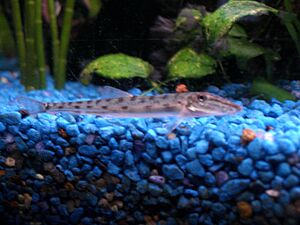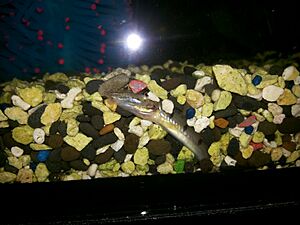Acantopsis dialuzona facts for kids
The Horseface Loach or Horsehead Loach is a unique fish known for its long, downturned snout, which looks a bit like a horse's face! Its scientific name is Acantopsis dialuzona.
This interesting fish lives in the fast-moving, clear streams and rivers of Southeast Asia. You can find it in countries like Indonesia, Peninsular Malaysia, and Thailand. Sometimes, it even shows up in flooded fields!
Quick facts for kids Acantopsis dialuzona |
|
|---|---|
 |
|
| Conservation status | |
| Scientific classification | |
| Synonyms | |
|
Contents
What's in a Name?
Scientists who study fish often give them special names to classify them. For a while, the Horseface Loach was known as Acantopsis choirorhynchos. But in 2012, a scientist named Maurice Kottelat reviewed these fish. He decided that A. choirorhynchos was actually the same species as A. dialuzona. So, A. dialuzona became the official name.
Horseface Loaches in Aquariums
If you're thinking about having a Horseface Loach as a pet, there's another fish called the longnose loach (Acantopsis octoactinotos) that looks very similar.
How to Tell Them Apart
- The Horseface Loach has that special downturned, horse-like nose. The longnose loach does not.
- Horseface Loaches love to bury themselves in sand or fine gravel at the bottom of their tank. Longnose loaches don't do this.
- Horseface Loaches are very fast swimmers. Longnose loaches are slower.
- Longnose loaches can be more aggressive and might even eat smaller fish. Horseface Loaches usually keep to themselves.
Setting Up Their Home
Because Horseface Loaches love to burrow, you need to make sure their tank has a soft bottom.
- Use sand or very fine gravel as the bottom material.
- They spend a lot of time buried, with only their eyes showing!
- If you have live plants, it's best to put them in pots. This stops the loaches from digging them up.
- These fish prefer dim lighting. Adding floating plants can help shade the tank.
What They Eat
Horseface Loaches aren't picky eaters. But they especially love live foods, like tubifex worms.
Their Habits
- Horseface Loaches are most active at night.
- They tend to be solitary, meaning they like to be by themselves.
- They can grow up to 30 centimetres (12 in) long, but they are considered adults when they reach about 6 centimetres (2.4 in).
- As of 1997, these fish had not been bred in captivity.
- The first Horseface Loaches were brought to Europe in 1929 by Edmund Riechers in Hamburg, Germany.
Local Names
See Also
- List of freshwater aquarium fish species




